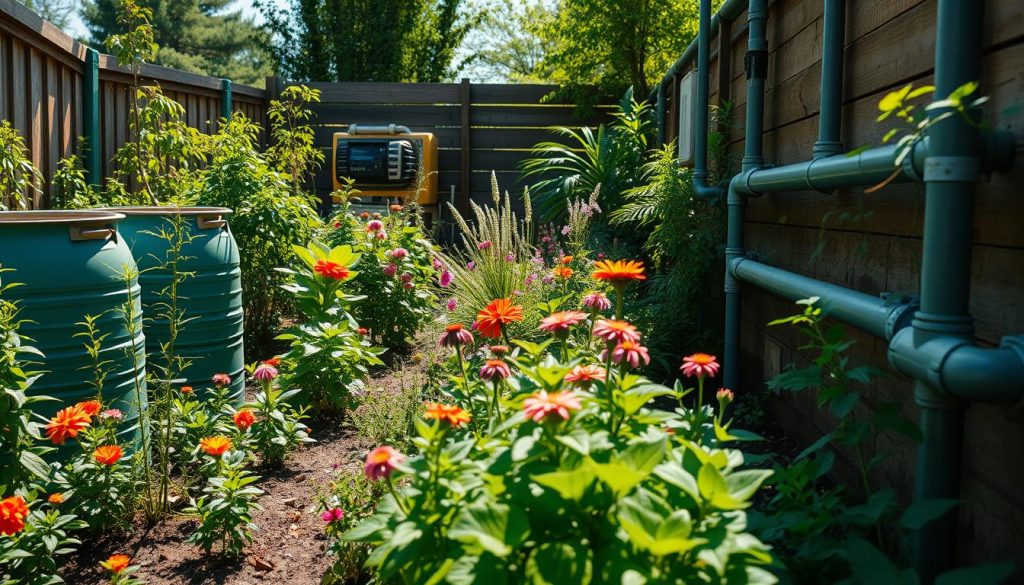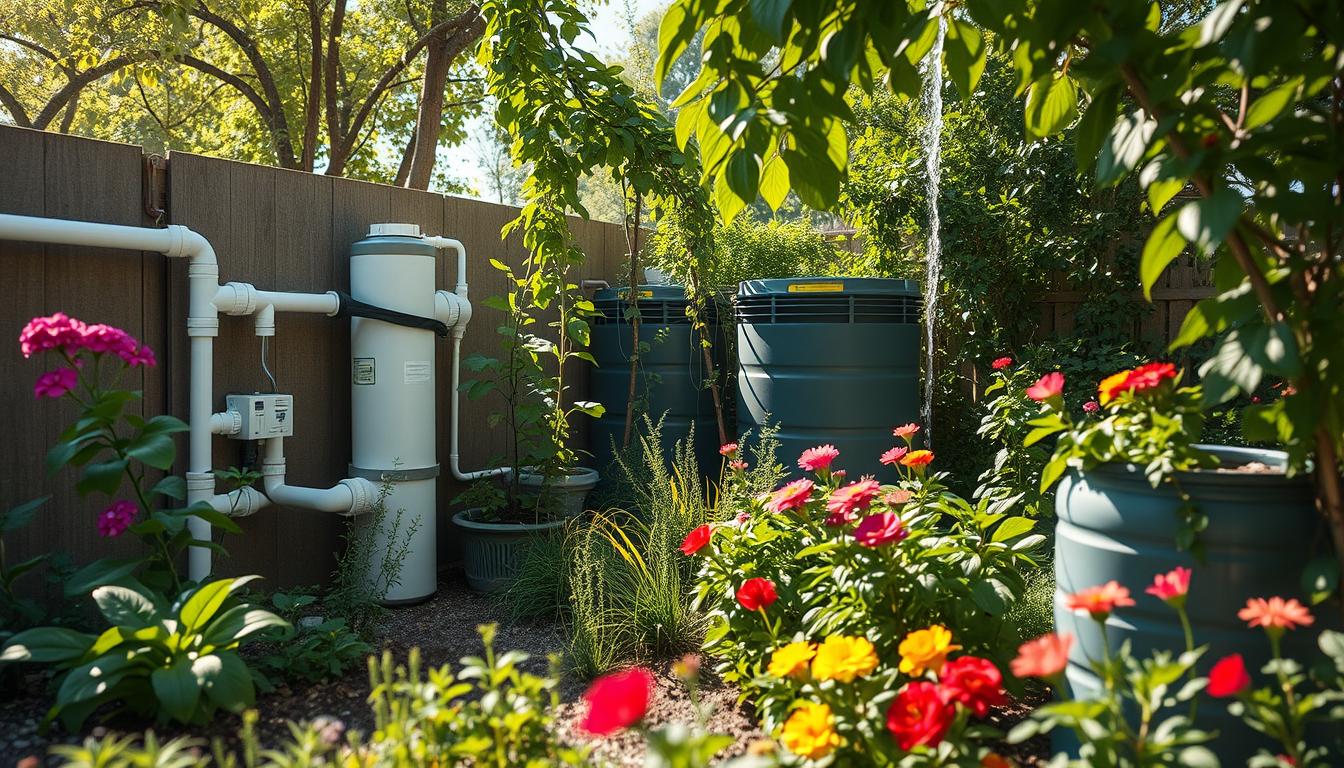I’ve found greywater systems to be a game-changer for my garden. They help with water conservation and sustainable living. Using greywater systems has cut down my water use and made my garden more eco-friendly.
Greywater systems are now a key part of my gardening. They help me save money on water bills and keep my garden healthy. In this article, I’ll share how greywater systems have changed my gardening. I’ll show why they’re important for a greener future.
Understanding Greywater and Its Benefits
Exploring greywater has opened my eyes to a new way of watering gardens. Greywater is the water from our daily activities like washing dishes and taking baths. Using a residential water reuse system can cut down on water use and help the environment.
Greywater systems offer many benefits. Let’s dive into the main advantages:
- Reduced water consumption: Using greywater for plants means using less fresh water.
- Lower water bills: A greywater system can save you money on your water bill.
- Environmental benefits: It helps keep our waterways clean by reducing pollution.
Learning about greywater systems has shown me how they can make gardening better for the planet. By using greywater, we can grow beautiful gardens and help the environment at the same time.
Next, I’ll look into the different types of greywater systems and how to pick the best one for my garden. But for now, I’m excited to have started understanding greywater’s benefits for eco-friendly gardening.
How Greywater Systems Work in Gardens
Exploring greywater systems is exciting. They help with water conservation in gardens. By using these systems, gardeners can save water and make their gardens more sustainable.
Greywater systems have a few key parts. These include a collection tank, treatment system, and a way to spread the water. Adding rainwater harvesting to these systems boosts water saving. This makes gardens healthy and green.
Basic Components of a Greywater System
- Collection tank: collects greywater from sinks, showers, and washing machines
- Treatment system: cleans the greywater so it’s safe to use again
- Distribution network: spreads the treated water to the garden or yard

Types of Greywater Systems for Home Use
There are different greywater systems for homes. Some use gravity, while others need a pump. The right choice depends on the gardener’s needs and situation.
Choosing the Right Greywater System for My Garden
I’m looking into getting a greywater system for my garden. It’s important to think about my garden’s size, water use, and local laws. Using greywater for plants helps save water and supports a healthy garden.
I’ve been researching different greywater systems. Some are perfect for small gardens, while others work better for bigger ones. I’m also interested in systems made for recycling greywater for plants.
Factors to Consider Before Installation
- Garden size and water usage
- Local regulations and permits required
- Type of plants and their water requirements
- Space available for the greywater system
Thinking about these points will help me pick the right system. I’m excited to look at all the options and find the best one for my garden. With the right system, I can save water and make my garden a healthy place for plants to grow.
Setting Up My Greywater System
I’m excited to share my journey with green gardening using greywater. This method has cut my water bills and made gardening more sustainable. With the right planning, anyone can have a lush garden with greywater.
First, you need to choose between doing it yourself or getting professional help. DIY can save money but takes more time. Professional help is quicker but costs more. Here are some tools and materials you’ll need:
- Greywater tanks and pumps
- Drip irrigation systems and soaker hoses
- Filters and treatment systems
Using these alternatives has cut my water use and made gardening more efficient. Drip irrigation and soaker hoses deliver water right to the roots. This cuts down on evaporation and runoff. 
DIY Installation vs. Professional Help
Choosing between DIY and professional help depends on your needs. DIY is fun but needs technical skills. Professional help is quicker but costs more. It’s up to you based on your preferences.
Recommended Tools and Materials
When picking tools and materials, consider the type of greywater system you want. Options include gravity-fed, pump-based, and hybrid systems. The right choice can make your garden water-efficient and eco-friendly.
Maintaining My Greywater System
To keep my greywater systems for gardens working well, I focus on regular upkeep. I watch the water quality and flow rates closely. I also do routine checks to spot any problems early. This way, I can fix issues before they get worse and keep my system running smoothly.
Some important maintenance tasks include:
- Checking the system for blockages or leaks
- Cleaning filters and screens to maintain water flow
- Inspecting pipes and fittings for signs of wear or damage
By doing these tasks regularly, I get to enjoy the perks of greywater systems. My garden uses less water and stays healthy and green.
Routine Maintenance Tasks
Regular upkeep is key to my greywater system’s success. I plan to check and inspect it often. This helps avoid problems and keeps my garden watered sustainably.
Troubleshooting Common Issues
If a problem pops up, I know how to fix it. I might look for blockages, check pipes for damage, or tweak the system’s settings. Being quick to solve problems helps my system run without a hitch, keeping my garden watered well.
Incorporating Greywater Into My Gardening Routine
I’ve learned to use greywater in my daily gardening routine. This helps me save water and reduce my environmental impact. It’s made my gardening more sustainable.
Greywater lets me water my plants more often without wasting clean water. My plants do well with it, especially those that need constant moisture. Some good plants for greywater include:
- Herbs like basil and mint
- Leafy greens like lettuce and kale
- Flowering plants like roses and lavender
Using eco-friendly watering methods has made my garden thrive. A residential water reuse system has been key. I’m excited to see more benefits from greywater irrigation.
I’m dedicated to sharing my gardening knowledge. Together, we can make our gardens and planet more sustainable.

Overcoming Challenges with Greywater Systems
Exploring greywater systems for my garden has shown me common challenges. Water quality is a big concern, but rainwater harvesting can help. This method not only improves water quality but also saves water.
Using eco-friendly landscaping practices helps avoid risks. Natural filters and regular upkeep keep water clean for plants. Adding rainwater harvesting to greywater systems cuts down on the need for drinking water.
It’s crucial to know local laws and follow them. This includes getting the right permits and making sure your system meets local standards. Regular checks and maintenance are also key to keeping the system clean.
- Obtaining necessary permits and approvals
- Ensuring system design and installation meet local standards
- Regularly inspecting and maintaining the system to prevent contamination
By tackling these challenges and using rainwater harvesting, you can make your garden sustainable. This not only helps your plants but also makes your community greener.
Success Stories: Greywater in Action
Reflecting on my journey with greywater in my garden, I’m inspired by others’ success. Their stories motivate me to keep saving water. They show how greywater recycling boosts plant growth and garden health.
Inspiring Examples from Fellow Gardeners
Mary, a local gardener, has seen her garden flourish with greywater. Her plants are now greener and her harvests bigger. She credits the greywater’s nutrients.
My neighbor, Sarah, cut her water bills by using greywater from her laundry. Her garden looks beautiful and uses less water.
How I’ve Benefited from My Greywater System
My greywater system has changed my garden for the better. Water from my washing machine and bathroom feeds my plants. Now, my veggies and flowers are healthier and more vibrant.
This has saved me money on water bills. I can now spend more on gardening.

